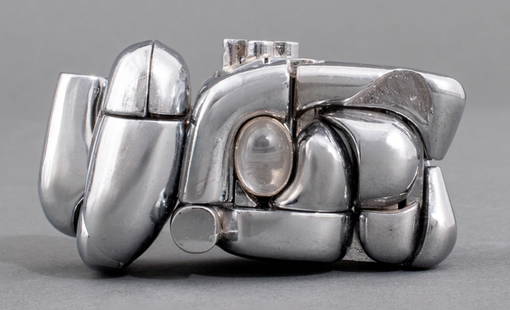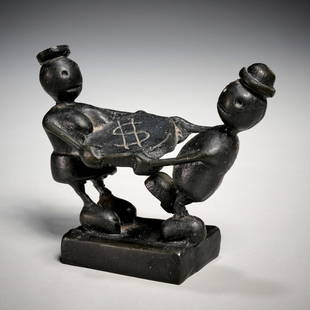
Phoenician marble sculpture of BA'AL HAMMON & TANIT
Similar Sale History
View More Items in Sculptures & CarvingsRelated Sculptures & Carvings
More Items in Sculptures & Carvings
View MoreRecommended Art
View More











Item Details
Description
Genuine Phoenician carved marble sculpture of BA'AL HAMMON & TANIT: 400-500 BC Figure of Phoenician god Tanit and Ba'al Hammon, chief god of Carthage. Measures: 7'' h. x 2 1/2 x 1 3/8 inches; Weight: lb. 3oz. = 1000g = 1 kg; Age: 400-500 BC; References: Baal-hamon. Ba'al-Hamon ("Ruler of a Crowd or Multitude") was the chief god of Carthage. He was a deity of sky and vegetation, depicted as a bearded older man with curling ram's horns.[1] Baʿal Hammon's female cult partner was Tanit. Cult and attributes: The worship of Baʿal Hammon flourished in the Phoenician colony of Carthage. His supremacy among the Carthaginian gods is believed to date to the 5th century BC, after relations between Carthage and Tyre were broken off at the time of the Punic defeat in Himera. Modern scholars identify him variously with the Northwest Semitic god El or with Dagon. In Carthage and North Africa Baʿal Hammon was especially associated with the ram and was worshiped also as Baʿal Qarnaim ("Lord of Two Horns") in an open-air sanctuary at Jebel Bu Kornein ("the two-horned hill") across the bay from Carthage. He was probably never identified with Baʿal Melqart, although one finds this equation in older scholarship. Ancient Greek writers identified him with the Titan Cronus. In ancient Rome, he was identified with Saturn, and the cultural exchange between Rome and Carthage as a result of the Second Punic War may have influenced the development of the Roman religious festival Saturnalia.[5] Greco-Roman sources report that the Carthaginians burned their children as offerings to Baʿal Hammon. (See Moloch for a discussion of these traditions and conflicting thoughts on the matter.) Attributes of his Romanized form as an African Saturn indicate that Hammon was a fertility god. Name and functions: The meaning of Hammon or Hamon is unclear. In the 19th century when Ernest Renan excavated the ruins of Hammon (Ḥammon), the modern Umm al-‘Awamid between Tyre and Acre, he found two Phoenician inscriptions dedicated to El-Hammon. Since El was normally identified with Cronus and Ba‘al Hammon was also identified with Cronus, it seemed possible they could be equated. More often a connection with Hebrew/Phoenician ḥammān 'brazier' has been proposed, in the sense of "Baal (lord) of the brazier". He has been therefore identified with a solar deity. Yigael Yadin thought him to be a moon god. Edward Lipinski identifies him with the god Dagon. Frank Moore Cross argued for a connection to Khamōn, the Ugaritic and Akkadian name for Mount Amanus, the great mountain separating Syria from Cilicia based on the occurrence of an Ugaritic description of El as the one of the Mountain Haman. Tanit: Tanit was a Phoenician lunar goddess, worshiped as the patron goddess at Carthage and Numidia.[2] Tanit might have an origin from Berber mythology in North Africa. Worship: Tanit was worshiped in Punic contexts in the Western Mediterranean, from Malta to Gades into Hellenistic times. From the fifth century BCE onwards Tanit's worship is associated with that of Ba`al Hammon. She is given the epithet pene baal ("face of Baal") and the title rabat, the female form of rab (chief). In North Africa, where the inscriptions and material remains are more plentiful, she was, as well as a consort of Baal Hammon, a heavenly goddess of war, a virginal (not married) mother goddess and nurse, and, less specifically, a symbol of fertility, as are most female forms. Several of the major Greek goddesses were identified with Tanit by the syncretic interpretatio graeca, which recognized as Greek deities in foreign guise the gods of most of the surrounding non-Hellene cultures. Her shrine excavated at Sarepta in southern Phoenicia revealed an inscription that identified her for the first time in her homeland and related her securely to the Phoenician goddess Astarte (Ishtar).[4] One site where Tanit is uncovered is at Kerkouane, in the Cap Bon peninsula in Tunisia. The origins of Tanit are to be found in the pantheon of Ugarit, especially in the Ugaritic goddess Anat (Hvidberg-Hansen 1982), a consumer of blood and flesh. There is significant, albeit disputed, evidence, both archaeological and within ancient written sources, pointing towards child sacrifice forming part of the worship of Tanit and Baal Hammon.[5] Tanit is also a goddess among the ancient Berber people. Her symbol, found on many ancient stone carvings, appears as a trapezium (trapezoid) closed by a horizontal line at the top and surmounted in the middle by a circle: the horizontal arm is often terminated either by two short upright lines at right angles to it or by hooks. Later, the trapezium is frequently replaced by an isosceles triangle. The symbol is interpreted by Hvidberg-Hansen as a woman raising her hands. In Egyptian, her name means Land of Neith, Neith being a war goddess. Long after the fall of Carthage, Tanit was still venerated in North Africa under the Latin name of Juno Caelestis, for her identification with the Roman goddess Juno.[6] Hvidberg-Hansen (Danish professor of Semitic philology), notes that Tanit is sometimes depicted with a lion's head, showing her warrior quality.[7] In modern times the name, with the spelling "Tanith", has been used as a female given name, both for real people and, more frequently, in occult fiction.
Condition
Excellent; normal aging wear of the marble
Buyer's Premium
- 0%
Phoenician marble sculpture of BA'AL HAMMON & TANIT
Estimate $50,000 - $100,000
2 bidders are watching this item.
Get approved to bid.
Shipping & Pickup Options
Item located in Tampa, FL, usSee Policy for Shipping
Payment

TOP



















































































